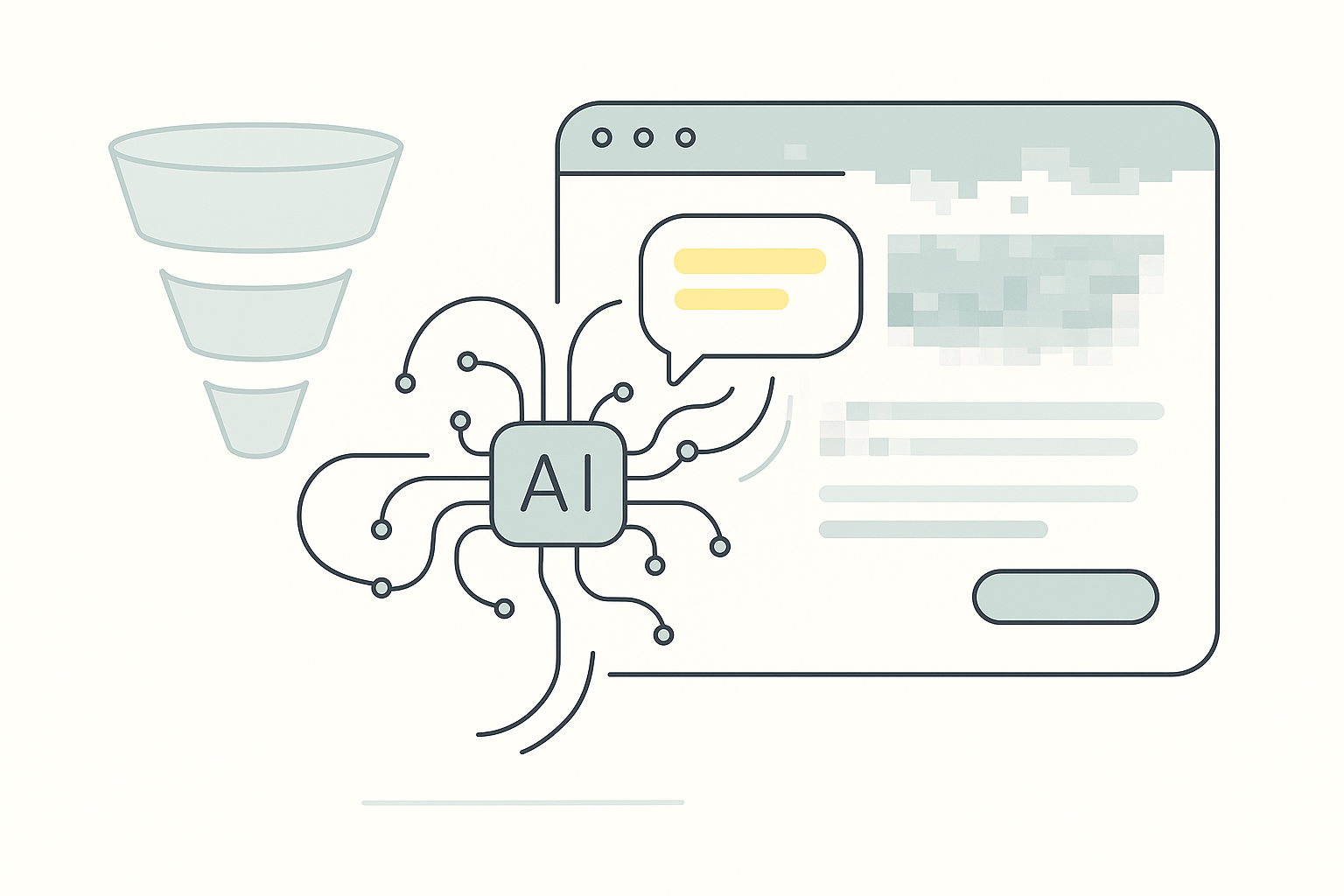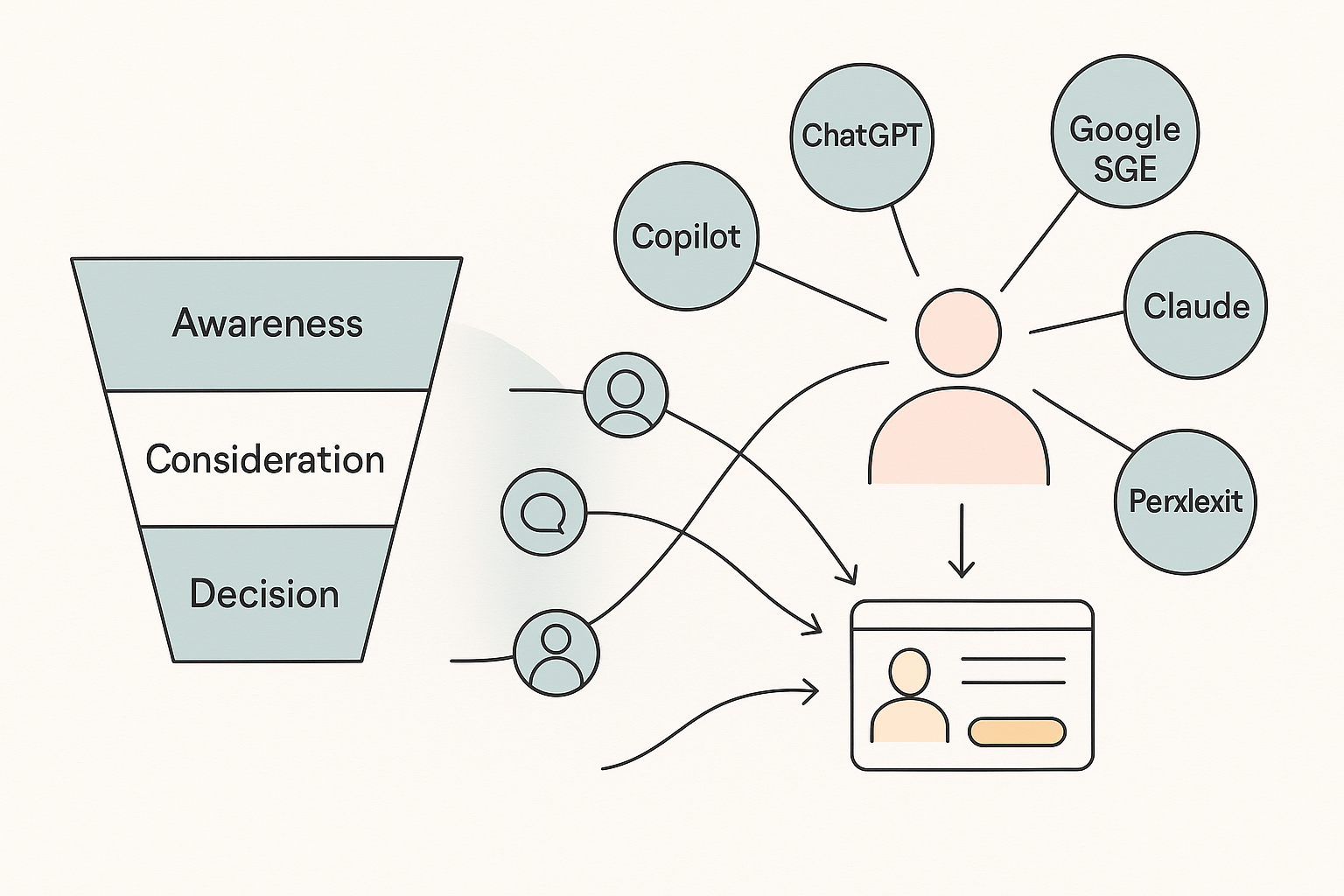How to Optimize Your Content for AI Search: Get Quoted, Get Seen, Drive Pipeline

AI Search Is Rewriting the Funnel
This isn’t a warning shot anymore.
AI search is already rewriting how your buyers discover, consume, and trust information. If your content isn’t built to get seen, summarized, and cited… it’s getting skipped.
And here’s the part most teams miss: traditional SEO still matters. Google’s still crawling. Rankings still drive trust. But showing up on page one doesn’t mean you’re part of the answer anymore.
You need to show up where humans scroll and where machines summarize.
What’s Actually Changed in Search Behavior
The way people search hasn’t disappeared… it’s fractured.
Buyers are still Googling. They’re still reading. But now, they’re also asking Perplexity to compare vendors. They’re pasting product names into ChatGPT to get summaries. They’re toggling between Copilot, Claude, and Google SGE to shortcut their research.
The journey doesn’t start with a search bar anymore. It starts with a question.
And if your content doesn’t show up in those answers — fast, clear, and credible — you don’t even make the shortlist.
Let’s put this into perspective:
Google’s SGE is generating AI answers for over 87% of all queries
Organic traffic has dropped by 30-70% in some industries since these tools launched
One study found top-ranking blogs lost 64% of their clicks: because the AI summary already gave the user what they needed
This shift isn’t speculative, this is the new standard in search marketing.
So if your strategy is still chasing clicks the old way, you’re aiming at a target that’s already moved.
What AI Tools Actually Look For
To win visibility in this new system, you need to understand how AI tools find and use your content.
AI search tools don’t browse like humans. They parse, extract, and summarize. They’re scanning for structure, clarity, freshness, and relevance. And if your content’s bloated, outdated, or buried in fluff? It won’t get picked.
Here’s how the major players actually work, and how to build content that fits their criteria.
Google SGE (Search Generative Experience)
SGE is Google’s generative AI layer, sitting on top of search results and pulling answers from the open web. It’s already active in the US and rolling out globally.
What it prioritizes:
Pages with clean structure and formatting (think logical headings, bullet points, and Q&A blocks that AI can parse without friction).
Content tagged with schema markup like FAQ or HowTo, which helps AI know exactly what your page is about.
Recency. Google favors content that’s fresh, timely, and updated often.
Answers pulled from multiple sources. Your content might be quoted… but probably not credited.
How to optimize:
Start each post with the main answer in plain language.
Break down supporting points into digestible bullets.
Use schema plugins like AIOSEO or Yoast to add structured data.
Revisit and refresh your content at least once a quarter.
Microsoft Copilot (Bing + Edge + Office)
Copilot pulls from Bing’s index to assist users inside tools like Edge, Teams, and Word. It’s designed to serve answers in productivity flows.
What it prioritizes:
Schema-backed pages and clean, modular layouts that are easy to lift into a document or email.
Clear, concise language that can stand on its own like a product spec block or a key insight.
Why it matters:
Your content could show up inside someone’s presentation, email thread, or strategy doc without them ever visiting your site. It’s ambient visibility.
How to optimize:
Write your content in blocks that are specific and portable.
Include visual separators like dividers, subheaders, and checklists.
Make sure every section could work as a quote tile or a meeting-ready takeaway.
ChatGPT (with browsing)
When browsing is enabled, ChatGPT pulls from live web content. But it’s not skimming top to bottom. It’s scraping fast and shallow.
What it prioritizes:
Lists, bullets, and clear formatting that surface quickly.
Content with fresh timestamps and a recent update history.
Unique points of view that don’t just repeat existing ideas.
How to optimize:
Lead with the sharpest point. Don’t make readers scroll for your best line.
Use a predictable format for each idea. Avoid long, meandering intros.
If you’re saying something different, make that clear early.
Claude (Anthropic)
Claude reads more like a human. It prefers logic and depth over shortcuts.
What it prioritizes:
Arguments with structure: if-this-then-that thinking, clearly explained frameworks, and step-by-step breakdowns.
New ways of looking at old problems. It prefers insight over volume.
How to optimize:
Frame each section with a goal or key takeaway.
Use logic to guide flow: Start broad, then narrow in.
Introduce frameworks and models with clear definitions.
Perplexity
Perplexity is AI search for researchers and power users. It always cites sources directly, which makes it one of the best engines for visibility.
What it prioritizes:
Direct answers upfront.
Credible stats, links, and sourceable data.
Schema and metadata that help identify you as the original source.
How to optimize:
Put your takeaway in the first paragraph, not the last.
Embed numbers, definitions, or industry facts they can cite.
Update the post every 3 to 6 months so it stays on the radar.
How to Upgrade Old Content for AI Visibility
You don’t need to burn your entire content library to keep up with AI search. But you do need to evolve it.
Start by prioritizing the posts that already bring in traffic, conversions, or backlinks. Go into Google Search Console, sort your top-performing pages, and flag the ones tied to lead gen, authority, or high impressions.
From there, apply these upgrades in batches:
Add schema markup using tools like Yoast, AIOSEO, or SEOPress. Choose FAQ or HowTo where it fits naturally.
Rewrite intros to surface the core answer in two sentences or less.
Break long paragraphs into bullets, questions, or quick-scan blocks.
Add a recent timestamp and short author bio to signal freshness and authority.
This is your AI-readiness checklist. Apply it to 3 to 5 posts a month. Treat it the same way you’d handle CRO testing: iterative, focused, and measurable!
Then run a visibility check.
Use Perplexity, ChatGPT with browsing, or Copilot to see if your content is getting surfaced. If it doesn’t show up, tweak your structure and try again. Think of this as visibility QA.
The faster you audit and adapt, the faster you’ll reclaim traction.
Search behavior isn’t static… and your content shouldn’t be either.
What This Means for Your Funnel
Your old funnel was simple:
Rank on Google → Get clicks → Nurture with content → Convert to lead.
Now, AI tools cut in at the very first step. If your content doesn’t show up in machine-summarized answers, your buyers never even hit your site.
This is what a zero-click world looks like. Your content still influences decisions… but it’s happening upstream. The insights you share are showing up in Perplexity threads, being paraphrased in ChatGPT, and pulled into buyer research through Microsoft Copilot—all before they ever land on your domain.
That’s still pipeline. Just not in the linear way your CRM might reflect.
So how do you track it?
Start with directional signals:
Watch for branded search increases after high-visibility content drops.
Add custom “How did you hear about us?” fields and actually read the responses.
Listen to sales calls for mentions of insights that sound eerily familiar.
If you’re relying only on last-click data, this kind of visibility gets lost. You might not get perfect attribution with old reports anymore. But if your quotes keep showing up across AI tools and your brand keeps coming up earlier in the conversation… That’s where trust builds. That’s where buyers form impressions. That’s where you show up before the demo request ever lands.

Why This Still Feeds Your Funnel (Even If You Can’t Track It)
Let’s be real > most CMOs still need numbers to prove marketing’s working. And this new world of ambient visibility makes that tricky. If your quote shows up in Perplexity or gets paraphrased by Copilot, there’s no referral source; i.e. no UTM tag and no session!
But that doesn’t mean it’s not working.
When your insights keep surfacing in the tools buyers trust, you’re shaping the narrative long before the first click.
You might notice more branded searches. Sales might start hearing “I saw your take on that in an AI thread.” Your LinkedIn might see more silent lurkers turn into demo requests.
That’s still pipeline, it just takes a different lens to see it.
Here’s how to connect the dots:
Track branded search lifts around the time high-visibility content drops.
Add “How did you hear about us?” fields on forms and read every word. Don’t just scan for channel data… listen for signals.
Tune in to sales calls. Your own phrasing might echo back at you… even if the prospect never touched your blog.
If you only chase last-click attribution, this layer will look invisible even though it’s not. This is building trust in the background.
And if your brand keeps showing up early, across multiple tools and conversations? That’s how modern buyers build conviction.
One Last Note Before We Wrap
If you’ve made it this far, you might be wondering… am I doing all of this myself?
The short answer: not yet.
Some of my own posts are still buried in long paragraphs without schema markup or quotable blocks :-\
Over the last few months, I’ve been intentionally upskilling while supporting others, mapping this shift from the inside out so I can help the marketers I mentor adapt faster than I did.
Because that’s the job, right? Make sense of the chaos… and then make it make sense for others.
In the next post, I’ll walk through how to actually retrofit your content… the tools, the structure, and the small changes that make AI pick it up.
If you’re rethinking your inbound game, that’s where we’ll get tactical.
👀 How This Blog Is AI-Optimized for Search Engines
Want to see what AI-search-friendly content actually looks like?
Below is a real FAQ block > structured exactly the way tools like Google’s SGE, Perplexity, and Bing Copilot prefer to extract and display content.
Frequently Asked Questions
Q: How do I structure my blog so AI can quote it?
Start with the core answer at the top. Use short, skimmable blocks: Q&As, bullet points, and schema. AI tools extract answers based on structure and clarity more than just keyword use.
Q: What kind of content gets cited by Perplexity or SGE?
Content that answers specific questions clearly, includes original insights or stats, and uses schema markup (like FAQ or HowTo). Long intros, jargon, or buried takeaways get ignored.
Q: Can I apply this to older content or do I need to rewrite everything?
You don’t need to start over. Audit your top 10 posts for traffic or leads, and refactor them: update the intro, break up paragraphs, add schema, and test for quote pickup in ChatGPT or Perplexity.
Q: Is schema markup enough on its own?
No. Schema helps machines parse the structure, but the content itself still needs to be clear, authoritative, and easy to extract. Schema gets you indexed, structure gets you surfaced.
Q: How can I tell if AI tools are using my content?
Manually test it: run your blog URL through Perplexity, Copilot, or ChatGPT with browsing. See if your answers are quoted, paraphrased, or missing entirely. Then adjust structure and test again.
Jahnavi Ray is a data obsessed marketing leader with 17+ years of experience driving demand, building GTM engines, and mentoring growth-stage B2B teams. She’s led marketing inside startups, scaled systems at global SaaS companies, and now shares her playbooks to help founders and marketers turn chaos into clarity, and pipeline into predictable revenue. When she’s not mapping growth ecosystems or coaching on GrowthMentor, you’ll find her practicing yoga, chasing her two gremlins, or building something meaningful in Toronto.